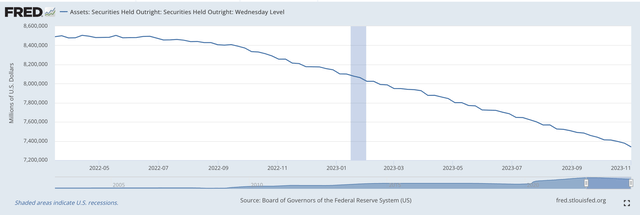Well, the Federal Reserve decided not to raise its policy rate of interest this past week.
The stock market rose!
The feeling seemed to be that the Fed had reached the top of its interest rate moves. Thursday the Dow Jones Industrial Average (DJI) rose by 223 points after a rise of 123 points on Wednesday.
The Standard & Poor’s 500 stock index (SP500) rose 44 points on Thursday after rising 27 points on Wednesday.
Both markets took off upwards on Friday.
Quantitative Tightening
Quantitative tightening continued.
For the banking week ending November 1, 2023, the Fed’s portfolio of securities bought outright declined by almost $40.0 billion.
The securities portfolio has dropped by $1,152.6 billion since the tightening program began in the middle of March 2022.

Securities Held Outright (Federal Reserve)
So, the Fed keeps its word and continues to steadily reduce the size of its securities portfolio.
As far as the impact of this reduction on the liquidity of the commercial banking system, the reserve balances held by commercial banks continue to hold relatively steady.
Steady, at least since around March of 2023.

Reserve Balances with Federal Reserve Banks (Federal Reserve)
I refer to this line item, Reserve Balances with Federal Reserve banks, as the “excess reserves” of the commercial banking system.
These reserve balances give us an idea of the amount of liquidity that exists within the commercial banking system.
From March 2022 through March 2023, reserve balances declined within the banking system as the Federal Reserve continued its quantitative easing.
But, something happened in March 2023…several commercial banks failed around that time.
The Federal Reserve, while continuing to oversee the reduction in its securities portfolio, saw to it that these “excess reserves” in the banking system rose in order to get the banking system through this relatively minor banking disturbance.
One can see, however, that the Federal Reserve did not back off from the increase in bank reserve balances at that time and has continued to keep reserve balances relatively constant.
One should note that Federal Reserve loans to the banking system rose around the March-April 2023 time period and currently there still remain loans of around $163.0 billion to the banking system.
This loan amount just about makes up the difference between reserve balances before the Fed moved in March and April to deal with the failing banks and reserve balances at the current time.
One should note this March/April time period, however, because of some other changes in banking statistics.
M2 Money Stock
Let’s take a look at the behavior of the M2 money stock.

M2 Money Stock (Federal Reserve)
Notice that the path of the M2 money stock turns downward in March 2022.
This is when quantitative tightening began.
Notice, also, that the decline in the M2 money stops in April of 2023…right around the time that the Fed was working with the failing banks.
The M2 money stock then rose a bit before settling back a bit over the next several months.
The point is, obviously, that there was a change in the data in the spring of 2023., And, this change seems to reflect the problems in the banking system and the response of the Federal Reserve to those problems.
This is the time period when the Federal Reserve opened its borrowing window and let commercial banks borrow monies as they needed in order to help the banking system get through that period as smoothly as possible.
The result, I believe, was positive, and the banking system then moved along without a real glitch – and here we are in November, still moving along smoothly.
But, of course, we still have $163.0 billion in loans to commercial banks on the Fed’s balance sheet.
Monetary Velocity
The one other piece of information I want to deal with today is the movement in the velocity of circulation of the M2 money stock.
As reported before, the velocity of the M2 money stock has been rising after it fell dramatically during the Covid-19 pandemic crisis.

Velocity of M2 Money Stock (Federal Reserve)
The velocity of the M2 money stock dropped off precipitously during the pandemic.
It has been rising relatively steadily over the past year couple of years, and these increases have not been insignificant.
M2 Money Stock Velocity
2022-I 1.158 2023-I 1.273
2022-II 1.179 2023-II 1.302
2022-III 1.202 2023-III 1.327
2022-IV 1.234
I call attention to this rising behavior because of the fact that the U.S. economy has been staying so strong at the same time that the Federal Reserve has been conducting a policy of quantitative tightening for almost 20 months now and has been raising it policy rate of interest in a pretty dramatic fashion.
But, look at the rate of growth of the U.S. economy in the third quarter of 2023.
Wow! The numbers knocked almost everyone over!
The markets are waiting for a recession, and the recession is not coming.
In fact, the economic growth numbers came in very, very strong.
The point here is that the efforts of the Federal Reserve to “tighten” the financial system to cool off economic growth and cool off inflation are being offset by the behavior in the private sector in the ways that people are using money.
The pandemic and all of its effects hit, and people sheltered their money.
Now, on the other side of the picture, when the Fed is trying to get inflation under control, people are spending more of their money at a faster pace.
So, there we are.
Federal Reserve Intentions
The Federal Reserve is still fighting inflation.
Federal Reserve officials continue to point to the need of continuing quantitative tightening.
So, it is expected that the Fed will continue to reduce the size of its securities portfolio. And, this may continue for an extended period of time.
But, for the time being, the Fed seems to be signaling that there will be no more increases in the Fed’s policy rate of interest…at least for the next several quarters.
But, what about the economy…and inflation?
To me, the recent performance of the economy points to two very important things.
First, there is still plenty of money out in the economy.
The efforts to fight the pandemic, and the recession, and the supply chain problems, and so forth, resulted in the Federal Reserve inserting a lot of money into the financial system.
Although it has reduced its securities portfolio by more than $1.0 trillion, there are still a lot of funds that still remain in the economy and can be used.
The major efforts to save the financial system and the economy still have an impact on what is happening now.
Second, it appears that people will continue to “spend” these monies, and the velocity of the money stock will continue to rise.
The velocity still has a long way to go to get back to where it was before all the turmoil took place in the 2020s.
So, the economy could stay “strong” for a longer period of time than expected, and inflation might stay higher than wanted for a longer period of time.
Read the full article here












Leave a Reply